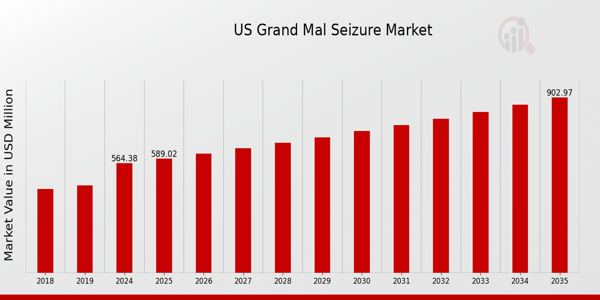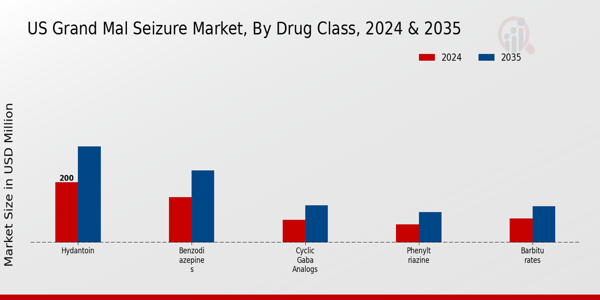US Grand Mal Seizure Market Overview
As per MRFR analysis, the US Grand Mal Seizure Market Size was estimated at 543.38 (USD Million) in 2023. The US Grand Mal Seizure Market Industry is expected to grow from 564.38(USD Million) in 2024 to 903 (USD Million) by 2035. The US Grand Mal Seizure Market CAGR (growth rate) is expected to be around 4.365% during the forecast period (2025 - 2035).
Key US Grand Mal Seizure Market Trends Highlighted
The US Grand Mal Seizure Market is experiencing significant trends that reflect the evolving landscape of epilepsy management. One notable trend is the growing awareness and diagnosis of epilepsy among both healthcare providers and patients. Increased education initiatives and campaigns by organizations such as the Centers for Disease Control and Prevention (CDC) have contributed to better recognition of seizure types, including Grand Mal seizures. This awareness is driving more patients to seek treatment options, thus increasing the demand for therapeutic solutions.
In recent years, there has been a shift towards newer antiepileptic drugs, which are now being favored for their improved efficacy and reduced side effects.Continued research and advancements in pharmacology are enabling the development of targeted therapies specifically for Grand Mal seizures.
Furthermore, patients are increasingly interested in alternative treatments, such as ketogenic diets and neuromodulation therapies, as viable options in managing their condition. This diversification in treatment approaches marks a notable trend in the US market. In addition, the regulatory environment in the US is becoming more favorable for drug approval processes, which encourages rapid introduction of innovative seizure treatments. The US Food and Drug Administration (FDA) has implemented streamlined pathways for potentially pivotal antiepileptic medications, enhancing opportunities for market players.
The growing utilization of telehealth services is also a relevant trend, as it allows patients to access expert consultations and ongoing management from the comfort of their homes, particularly significant during times of public health concerns like the COVID-19 pandemic. Overall, the convergence of heightened awareness, innovative treatments, supportive regulations, and telehealth integration are key market drivers shaping the future of the Grand Mal seizure market in the US. These elements present numerous opportunities for healthcare providers and pharmaceutical companies to expand their solutions and improve the quality of life for individuals affected by Grand Mal seizures.

Source: Primary Research, Secondary Research, Market Research Future Database and Analyst Review
US Grand Mal Seizure Market Drivers
Increasing Prevalence of Epilepsy Disorders
The rising number of individuals diagnosed with epilepsy in the United States is a significant driver for the US Grand Mal Seizure Market Industry. According to the Centers for Disease Control and Prevention, approximately 3.4 million people in the US are affected by epilepsy, with a considerable proportion suffering from Grand Mal seizures. This alarming statistic highlights the growing demand for effective treatments and management solutions in the market.As the cases of epilepsy continue to rise, particularly in children and older adults, there is an increasing necessity for novel therapeutic interventions and drug development.
Organizations such as the Epilepsy Foundation are actively involved in promoting awareness, research funding, and education initiatives to address the needs of this community, further driving the market growth in this sector.
Advancements in Research and Development
The US Grand Mal Seizure Market Industry is witnessing substantial growth due to the continuous advancements in Research and Development (R&D) related to seizure medications and therapies. In recent years, several pharmaceutical companies such as Pfizer and Johnson & Johnson have heavily invested in R&D to develop new antiepileptic drugs and innovative treatment modalities.
Statistics from the National Institutes of Health indicate that the funding for epilepsy research has increased by more than 24% over the past five years, focusing on improving the efficacy and safety profile of treatments available for Grand Mal seizures.This ongoing R&D effort not only expands the treatment options available but also increases the market's attractiveness for investors and healthcare providers alike.
Growing Awareness and Diagnosis of Epilepsy
Increased awareness and education about epilepsy in the United States is playing a pivotal role in driving the US Grand Mal Seizure Market Industry. Initiatives aimed at reducing stigma and promoting early diagnosis are resulting in higher rates of people seeking medical help for seizure disorders. According to the American Epilepsy Society, awareness programs have led to a reported increase in timely diagnoses by approximately 15% over the last decade.The rise in awareness campaigns and the integration of epilepsy education in schools and communities facilitate quicker access to healthcare solutions.
This trend is further supported by organizations like the CDC, which emphasizes public health initiatives to inform citizens about the signs, symptoms, and available treatments for epilepsy.
US Grand Mal Seizure Market Segment Insights
Grand Mal Seizure Market Drug Class Insights
The US Grand Mal Seizure Market, particularly within the Drug Class segment, portrays a growing and evolving landscape critical for addressing seizure disorders. This segment comprises several important classifications of antiepileptic medications designed to manage Grand Mal seizures effectively. Antiepileptic drugs such as hydantoins are notable for their historical role in treatment efficacy and their mechanism in stabilizing neuronal membranes. Benzodiazepines, widely acknowledged for their rapid action, play a key role in acute seizure management, thus emphasizing their importance amid treatment options.
Barbiturates, although less commonly used today due to potential dependency, still hold a significant place in the pharmacological toolbox for severe epilepsy cases. The cyclic GABA analogs are gaining attention for their unique ability to enhance GABA activity in the brain, offering an alternative pathway for seizure control. Iminostilbenes have emerged as a viable choice for many patients, especially for individuals with specific types of epilepsy that are resistant to other treatments.
Aliphatic carboxylic acids are crucial for patients requiring alternative therapies; they contribute to a more comprehensive treatment strategy, accommodating diverse patient profiles and enhancing therapeutic outcomes. The other categories within the Drug Class segment underscore the breadth of options available, ensuring tailored approaches to individual patient needs are achievable. The segmentation of the US Grand Mal Seizure Market by drug class reflects an array of treatment philosophies and approaches.
As advancements in pharmacology continue to unfold, market growth is likely to be driven by the development of new drugs aimed at improving efficacy, reducing side effects, and addressing the unique needs of patients across various demographics.
This evolution is supported by ongoing Research and Development initiatives focused on understanding the pathophysiology of Grand Mal seizures and translating those insights into innovative therapies, thereby reinforcing the vital role of the Drug Class in the overall management of seizure disorders in the US population. The availability of diverse drug classes is essential, as it creates opportunities for healthcare providers to customize treatment plans that align with the specific medical histories and preferences of patients, ultimately aiming for better control of seizure episodes and improved quality of life.

Source: Primary Research, Secondary Research, Market Research Future Database and Analyst Review
Grand Mal Seizure Market Diagnosis Insights
The Diagnosis segment of the US Grand Mal Seizure Market is crucial as it encompasses various diagnostic tools essential for the accurate identification of seizure disorders. Magnetic resonance imaging (MRI) is notably significant, offering detailed images of brain structures which aid in detecting underlying conditions contributing to seizures. Electroencephalogram (EEG) plays a central role by measuring electrical activity in the brain, thus helping clinicians monitor and diagnose seizure types effectively.
Blood tests are also important in ruling out metabolic and infectious causes of seizures, providing a comprehensive approach to diagnosis.Computed tomography (CT) is widely used in emergency settings for its speed and effectiveness in detecting acute intracranial issues, making it invaluable in urgent care scenarios. Additionally, other diagnostic methods contribute to a holistic understanding of patient conditions. Overall, these diagnostic instruments drive the market by enhancing the precision of diagnosis, improving treatment planning, and ultimately leading to better patient outcomes in managing Grand Mal seizures across the US.
The evolution in these diagnostic methods continues to influence changes in clinical practice, emphasizing the need for innovation and advancements in neurology.
Grand Mal Seizure Market Drug Generation Insights
The Drug Generation segment within the US Grand Mal Seizure Market has evolved significantly, encompassing a range of therapies designed to manage this serious condition. The first generation of drugs laid the groundwork for seizure control, introducing foundational treatments that have been essential for patient management. As the industry progressed, the second generation of therapies emerged with improved efficacy and safety profiles, offering better options for those who do not respond adequately to earlier medications.
The third generation of drug therapies represents a significant advancement, exhibiting enhanced mechanisms of action and a reduced side effect profile, thus catering to a more diverse patient population.This evolution reflects the ongoing commitment to Research and Development within the US healthcare sector, addressing the unique challenges faced by individuals with Grand Mal seizures. Market dynamics indicate that addressing patient-specific responses and optimizing treatment regimens remains a priority, reinforcing the importance of understanding the nuanced effectiveness of each generation.
The growing prevalence of epilepsy in the US drives the demand for innovative solutions, propelling advancements that promise to enhance patient outcomes and quality of life.As the US Grand Mal Seizure Market continues to expand, these drug generation advancements are crucial in offering hope and improved treatment options for affected individuals.
Grand Mal Seizure Market Surgery Insights
The US Grand Mal Seizure Market within the Surgery segment is seeing an increased focus as treatments advance and awareness grows. Within this domain, multiple subpial transections are gaining traction, particularly as they offer a tailored approach to disrupting the seizure pathways while preserving functional brain areas. Resective surgery continues to dominate due to its effectiveness in removing the origin of seizures, making it a preferred choice among practitioners and patients.
Corpus callosotomy plays a critical role in cases with severe, drug-resistant epilepsy, providing another strategy to limit seizure spread.Hemispherectomy, often considered for extreme cases, demonstrates significant results in improving quality of life for select patients. Each of these surgical options has its unique benefits and challenges, which contribute to their importance in the overall US Grand Mal Seizure Market landscape. The increasing prevalence of epilepsy, enhanced surgical techniques, and a growing focus on personalized treatment solutions are propelling advancements in surgical methods, driving demand and opportunities within this market segment.
The continued research and development efforts in this area highlight the potential for improved patient outcomes.
Grand Mal Seizure Market End Users Insights
The US Grand Mal Seizure Market encompasses a range of End Users, including academic and research centers, neurological centers, hospitals, and others, each playing a crucial role in advancing care and treatment options. Academic and research centers contribute significantly to the development of innovative therapies and solutions through extensive Research and Development, aiding in the understanding of seizure mechanisms and potential breakthroughs.
Neurological centers are essential as they provide specialized care and management for patients, often utilizing advanced diagnostic tools and treatments that can enhance patient outcomes.Hospitals serve as pivotal points for immediate care and intervention, addressing acute cases and facilitating comprehensive treatment pathways. Additionally, other entities, such as outpatient clinics and rehabilitation centers, are increasingly important as they support ongoing care and therapy, reflecting the growing recognition of the need for holistic approaches to seizure management.
The interconnectedness of these End Users illustrates a comprehensive healthcare landscape that collectively drives improvements in care standards and opportunities for advancements in the US Grand Mal Seizure Market, highlighting the importance of integrated approaches to patient management and treatment strategies in this evolving sector.As the demand for such services continues to rise, this segment is expected to respond robustly to the increasing prevalence of seizure disorders, thereby contributing significantly to the overall growth of the market.
US Grand Mal Seizure Market Key Players and Competitive Insights
The competitive landscape of the US Grand Mal Seizure Market is marked by the presence of several key players, all striving to develop innovative therapies and treatment options for patients suffering from seizures. This market has seen significant growth due to factors such as increasing prevalence of epilepsy, advancements in technology, and a stronger focus on improving patient outcomes. Companies are increasingly investing in research and development to create novel anticonvulsants and explore potential synergistic combinations that enhance efficacy while minimizing side effects.
Moreover, the regulatory framework in the United States necessitates rigorous testing and approval processes, but successful navigation of these challenges can lead to lucrative opportunities for those who emerge as leaders in the market.
Bristol Myers Squibb is recognized for its strong presence within the US Grand Mal Seizure Market, particularly through its commitment to innovation and a robust pipeline of therapeutic products. The company leverages its substantial research resources to tackle complex neurological conditions, focusing on mechanisms that extend beyond traditional treatment options. Bristol Myers Squibb benefits from its established brand reputation, ensuring physician and patient trust in the effectiveness of its medications.
Through strategic collaborations and extensive clinical trial networks, the company is well-positioned to maintain its competitive edge in the market by delivering effective therapies that cater to the nuanced needs of patients.
Novartis also exhibits a formidable presence in the US Grand Mal Seizure Market, emphasizing its dedication to advancing patient care through a range of specialized products and services targeting seizure disorders. The company offers several key antiepileptic drugs which are well-regarded for their efficacy and safety profiles, placing Novartis in a competitive position. The strength of Novartis lies not only in its expansive product portfolio but also in its active involvement in clinical research and real-world evidence studies that validate the effectiveness of its therapies.
Mergers and acquisitions have further bolstered Novartis' position by enabling it to access cutting-edge technologies and expand its market reach. The company remains committed to addressing the challenges of their diverse patient populations, ensuring sustained growth in the US market through innovation and strategic partnerships focused on enhancing therapeutic outcomes for individuals experiencing Grand Mal seizures.
Key Companies in the US Grand Mal Seizure Market Include
US Grand Mal Seizure Market Industry Developments
Recent developments in the US Grand Mal Seizure Market reflect significant activity among major pharmaceutical companies. Bristol Myers Squibb and Novartis have advanced their Research and Development initiatives focusing on new therapies for seizure disorders. In terms of mergers and acquisitions, AstraZeneca acquired a promising biopharmaceutical firm in February 2023, enhancing its portfolio aimed at neurological conditions. Eli Lilly completed its acquisition of a technology firm specializing in epilepsy treatment in March 2023, which is expected to bolster its innovation efforts in the Grand Mal Seizure segment.
The market valuation for companies like GlaxoSmithKline, Otsuka Pharmaceutical, and UCB has seen growth due to increasing investments in epilepsy management and rising awareness about seizure disorders. Additionally, in the last two years, the US government has shown increased support for seizure disorder research funding through the National Institutes of Health, indicating a renewed focus on treatment innovation. This environment creates further opportunities for companies like Seagen, Pfizer, and AbbVie, as they explore new therapeutic avenues, which could impact overall market dynamics and drive competition in the sector.
US Grand Mal Seizure Market Segmentation Insights
Grand Mal Seizure Market Drug Class Outlook
- aliphatic carboxylic acid
Grand Mal Seizure Market Diagnosis Outlook
- electroencephalogram (EEG)
Grand Mal Seizure Market Drug Generation Outlook
Grand Mal Seizure Market Surgery Outlook
- multiple subpial transections
Grand Mal Seizure Market End Users Outlook
- academic and research centers
| Report Attribute/Metric Source: |
Details |
| MARKET SIZE 2018 |
543.38(USD Million) |
| MARKET SIZE 2024 |
564.38(USD Million) |
| MARKET SIZE 2035 |
903.0(USD Million) |
| COMPOUND ANNUAL GROWTH RATE (CAGR) |
4.365% (2025 - 2035) |
| REPORT COVERAGE |
Revenue Forecast, Competitive Landscape, Growth Factors, and Trends |
| BASE YEAR |
2024 |
| MARKET FORECAST PERIOD |
2025 - 2035 |
| HISTORICAL DATA |
2019 - 2024 |
| MARKET FORECAST UNITS |
USD Million |
| KEY COMPANIES PROFILED |
Bristol Myers Squibb, Novartis, AstraZeneca, Eli Lilly, GlaxoSmithKline, Otsuka Pharmaceutical, UCB, Seagen, Pfizer, AbbVie, Sanofi, Johnson and Johnson, Mylan, Lundbeck |
| SEGMENTS COVERED |
Drug Class, Diagnosis, Drug Generation, Surgery, End Users |
| KEY MARKET OPPORTUNITIES |
Advanced seizure monitoring technologies, Novel anti-epileptic drugs, Increased telemedicine accessibility, Enhanced patient education programs, Growing awareness and advocacy initiatives. |
| KEY MARKET DYNAMICS |
increasing prevalence of epilepsy, growing demand for effective treatments, advancements in drug development, rising awareness and education, regulatory support and approvals |
| COUNTRIES COVERED |
US |
Frequently Asked Questions (FAQ):
The US Grand Mal Seizure Market is expected to be valued at 564.38 million USD in 2024.
By 2035, the US Grand Mal Seizure Market is projected to reach a value of 903.0 million USD.
The expected CAGR for the US Grand Mal Seizure Market from 2025 to 2035 is 4.365%.
The hydantoin drug class is expected to dominate the US Grand Mal Seizure Market, valued at 320.0 million USD by 2035.
In 2024, the market value for benzodiazepines is 150.0 million USD, projected to grow to 240.0 million USD by 2035.
The market value for cyclic GABA analogs in the US Grand Mal Seizure Market is 74.38 million USD in 2024.
The key players in the US Grand Mal Seizure Market include Bristol Myers Squibb, Novartis, AstraZeneca, Eli Lilly, and GlaxoSmithKline.
The barbiturates segment is valued at 80.0 million USD in 2024 and is expected to reach 120.0 million USD by 2035.
Emerging trends in the US Grand Mal Seizure Market present opportunities for innovations in drug development and patient management.
The US Grand Mal Seizure Market may face challenges such as regulatory hurdles and competition from alternative therapies.
















